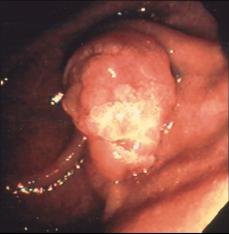Complications
Children with a family history of FAP have an 800-fold increased risk for hepatoblastomas by 7 years of age, and 0.3% of young children with FAP develop these aggressive tumors. Boys with FAP may be roughly 2 times more likely to have this rare form of liver cancer.[77][78][79][80]
Recommendations for hepatoblastoma screening in patients with FAP vary. Some have suggested annual abdominal ultrasound and serum alpha-fetoprotein testing for children with a family history of FAP.[12][40] The National Comprehensive Cancer Network suggests liver palpation, abdominal ultrasound, and measurement of AFP every 3-6 months during the first 5 years of life, but the guidelines note that high-level evidence to support this is lacking.[9] The European Society for Paediatric Gastroenterology Hepatology and Nutrition guideline recommends against routine screening for hepatoblastoma.[24]
Adolescent boys with FAP can rarely develop a vascular nasopharyngeal angioma in the nares or nasopharynx. These locally invasive tumors are not known to have malignant potential.[84]
Duodenal polyps are present in nearly 90% of patients with FAP by 70 years of age, but progression to malignancy can be prevented with vigilant endoscopic surveillance. Duodenal cancer is the second leading cause of cancer death in patients with FAP.[67][68][69][Figure caption and citation for the preceding image starts]: Periampullary polypsFrom the personal collection of Lisa A. Boardman, MD; used with permission [Citation ends].
Cystic fundic gland polyps occur in up to 60% of patients with FAP/attenuated FAP but in <2% of the general population.
In patients with FAP/attenuated FAP these typically benign polyps can develop dysplasia, and gastric cancer in association with extensive fundic gland polyps has occurred in patients with FAP.[12][81][82][83]
Approximately 15% of patients with FAP will develop desmoids.
Desmoids are fibromatous masses that can become locally invasive. They are a leading cause of death for patients with FAP.[54]
Pharmacologic therapy is usually the preferred initial approach when compared to surgery.[28] Surgery can stimulate intra-abdominal desmoid tumor growth in patients with FAP and is only typically offered to symptomatic patients who do not respond to initial medical therapy.[28]
Iron deficiency anemia and vitamin B12 deficiency occur more commonly in patients with FAP following IPAA (restorative proctocolectomy) than in patients with chronic ulcerative colitis. Annual laboratory testing for iron and vitamin B12 levels is recommended.[85]
Colorectal cancer develops as a consequence of germline adenomatous polyposis coli mutations in nearly 100% of patients with FAP by 40 years of age if prophylactic colectomy is not performed, and in 80% of patients with attenuated FAP by 60 years of age if polyps are not managed endoscopically or surgically.[2][11]
The relative risk of cerebellar medulloblastoma in patients with FAP is 92 times higher than in the general population.[74] Because brain tumors are rare in the general population, the absolute lifetime risk is 1% to 2%.[75] Patients should be counseled about symptoms and signs of medulloblastoma, such as horizontal diplopia, clumsiness, ataxia, headaches, and vomiting. Treatment includes surgery, radiation therapy, and/or chemotherapy. Overall 5-year survival is 50% to 70%.[75]
Thyroid cancer risk is increased in patients with FAP, and tumors typically occur between ages 25 and 33 years. Typically the tumors arise in young adult women (ages 25-33 years).
The majority of these cancers are papillary tumors and have an excellent prognosis. Preventive screening is recommended. Guidelines differ with regard to recommendations for thyroid screening, although most recommend annual ultrasound of the thyroid gland, with or without physical exam.[29][28][40] European guidelines recommend starting screening at age 25-30 years, or when colorectal polyposis is diagnosed, whichever comes first.[40] The National Comprehensive Cancer Network differs in that it recommends a baseline thyroid ultrasound in late adolescence, with a follow-up every 2-5 years. Shorter follow-up intervals may be considered for patients with a family history of thyroid cancer.[9] Nodular thyroid disease is also common in patients with FAP. Even small nodules can be malignant, and close follow-up of nodules is warranted.[76]
Use of this content is subject to our disclaimer